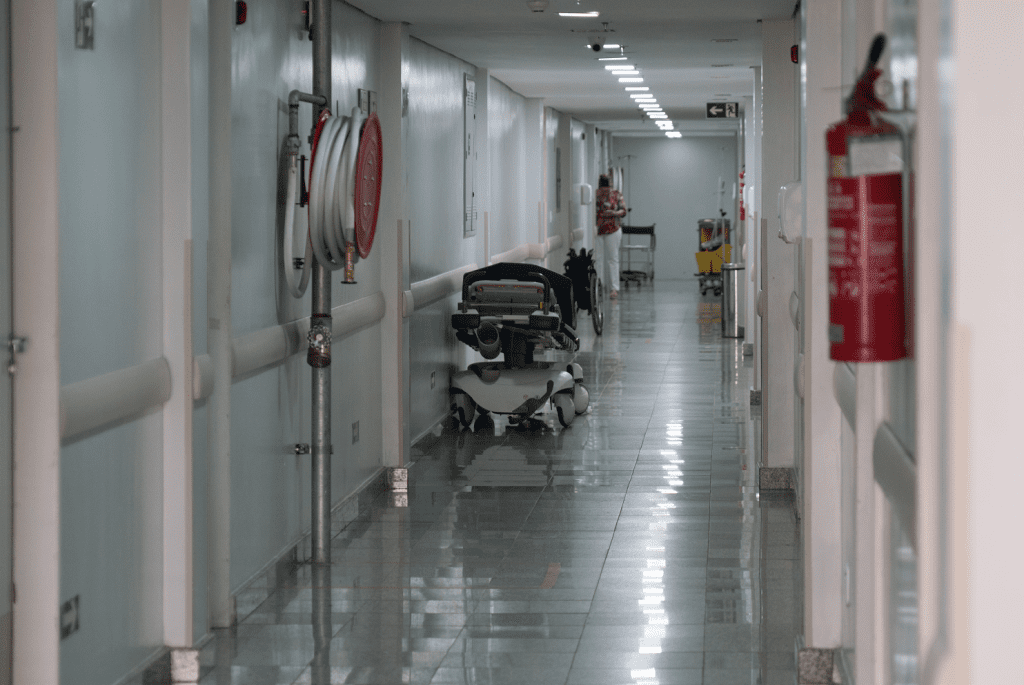
Preventing Violence in Health Care Workplaces

Written by: Joe Mangiardi, NES, Inc.
 Violence in health care workplaces occurs for a wide range of reasons, from drug-addicted patients to overworked and tired employees to stressed-out and anxious visitors. It is important to have certain plans and policies in place in order to reduce the frequency and severity of violent events.
Violence in health care workplaces occurs for a wide range of reasons, from drug-addicted patients to overworked and tired employees to stressed-out and anxious visitors. It is important to have certain plans and policies in place in order to reduce the frequency and severity of violent events.
Violence in Health Care & Cal/OSHA
Regulations enacted by the California Occupational Safety and Health Administration (Cal/OSHA) aimed at reducing violence in health care workplaces began to take effect on April 1, 2017, with subsequent compliance deadlines on July 1, 2017 and April 1, 2018. Known as the Workplace Violence Prevention in Healthcare Standard, the legislation established various protocols and definitions that must be followed to help protect health care industry employees.
According to U.S. News article Violence in the Health Care Workplace, health care workers experience approximately 654,000 on-the-job injuries per year, the most of any profession. Exposure to blood, body fluids, and other potentially hazardous materials along with certain injury types such as back strains and needle/sharps wounds are workplace hazards many would expect in such an environment. However, 45% of all workplace violence incidents occur in health care, and there has been an increase in violence in health care settings over recent years.
Regulation Deadlines & Requirements
NOTE: health care facilities scheduled to close by the end of 2021 are exempted from these requirements.
By April 1, 2017 affected health care employers must have implemented a Violent Incident Log in which to record all violent incidents that occur in the workplace, regardless of an injury having resulted from the event. Certain other recordkeeping requirements must also have been adhered to by this date including logging identified workplace hazards and employee training. Upon request, records must be made available to the Cal/OSHA Chief or designated representative and any employees and their representatives.
By July 1, 2017 general acute care hospitals, acute psychiatric hospitals, and special hospitals must report certain violent incidents directly to Cal/OSHA (for information on how hospitals are to register in Cal/OSHA’s workplace violence reporting system, visit the Cal/OSHA Workplace Violent Incident Reporting System for Hospitals webpage).
The most significantly impactful deadline occurred on April 1, 2018. By this date affected employers must have implemented a written Workplace Violence Prevention Plan (Plan) into their Injury and Illness Prevention Program (or developed it as a separate document). The Plan is to apply in all units, services, and operations and is to be specific to hazards inherent to those respective activities. The Plan must include the following elements:
- Names/titles of those responsible for maintaining the Plan
- Procedures for effectively incorporating employees and their representatives in developing and maintaining the Plan including identifying and correcting workplace hazards, reporting incidents of violence, and designing training
- Methods to use in implementing the Plan including ensuring that proper training is provided and workplace violence incidents are recorded and investigated
- Protocols for acquiring assistance from law enforcement when a violent incident occurs
- Effective procedures for the employer to follow when a violent incident is reported including ensuring no retaliatory action is taken against an employee making such a report
- Provisions ensuring that both supervisory and non-supervisory employees adhere to the Plan’s stipulations
- Procedures to inform employees about reporting workplace violence, their right to report without reprisal, how investigations will be conducted, and how corrective actions will be applied
- Description of how training will be developed
- Process for identifying, evaluating, and correcting workplace hazards including a review of incidents that occurred in the past year (see regulations for individual criteria pertaining to fixed workplaces, home health care or hospices, and emergency medical services/transport)
- Procedures to identify and evaluate patient-specific risk factors and warning signs in visitors or other non-employees
- Procedures to promptly correct identified workplace violence hazards and contingencies for when such hazards cannot be immediately corrected
- Post-incident response and investigation protocols
 It is important that health care employees learn to be aware of the signs that a patient is unstable and may become violent.
It is important that health care employees learn to be aware of the signs that a patient is unstable and may become violent.
In developing the Plan the employer must conduct environmental assessments, perform remedial actions, redesign the health care facility to decrease the risk of violence, install and maintain an alarm system that meets regulatory requirements, organize the involvement of employees, appropriately systematize staffing arrangements, and implement a training program consisting of initial and scheduled refresher training.
Training must cover the following:
- Explanation on the details and procedures contained in the Plan
- How to recognize the potential for violence, how to counteract factors that could escalate violence, and when and how to seek assistance
- Strategies for avoiding physical harm
- Recognition of alerts, alarms, or other emergency warnings and how to use identified escape routes or applicable evacuation/shelter areas
- Private security personnel, if any
- Reporting violent incidents to law enforcement
- Available resources for coping with incidents of violence
- Interactive Q&A with someone knowledgeable about the Plan
Further training is to be provided, as needed, whenever conditions/equipment change and for employees in specific roles and/or locations requiring additional job function-specific information.
By April 1, 2018 employers must also have set up a process for reviewing the Plan that evaluates the operation and distribution of staff members, alarm systems, and equipment/facilities. The review must examine security risks affecting particular units or operations such as late or early shifts, zones with uncontrolled access, and employee parking areas. The review must include a means for implementing newly discovered hazards in the Plan and for addressing any components of the Plan that may be deficient in any way.
 Parking lots can be dangerous for late-night and early morning shifts; additional lighting and security are protective measures that an employer can consider.
Parking lots can be dangerous for late-night and early morning shifts; additional lighting and security are protective measures that an employer can consider.
Violence in Health Care: Key Definitions
Codified as California Code of Regulations (CCR) Title 8 §3342, the regulations define workplace violence as “any act of violence or threat of violence that occurs at the work site” and adds that “the term workplace violence shall not include lawful acts of self-defense or defense of others.” Types of workplace violence are any that involve the use, or threat of use, of physical force against an employee that results, or could likely result, in bodily, emotional, and/or psychological injury. Further qualifying events are any that feature firearms or any other dangerous or potentially dangerous weapons, even if such weapons are common objects. These criteria apply regardless of whether the employee sustains an injury.
Workplace violence occurrences are broken down by 8 CCR §3342 into four types:
- “Type 1 violence” is committed by someone who does not have a legitimate reason to be on the premises and includes premeditated violent acts and/or crimes
- “Type 2 violence” is violence inflicted upon an employee by non-employees whose presence is inherent to operations, such as customers, clients, patients, students, inmates, or visitors
- “Type 3 violence” is sustained by an employee as inflicted by a current or prior employee, supervisor, or manager
- “Type 4 violence” applies when a non-employee is known to have, or have had, a personal relationship with an employee and commits an act of violence in that employee’s workplace
It is also helpful to understand what qualifies as a health facility. As presented in 8 CCR §3342, a health facility is “any facility, place, or building that is organized, maintained, and operated for the diagnosis, care, prevention, or treatment of human illness, physical or mental, including convalescence and rehabilitation and including care during and after pregnancy, or for any one or more of these purposes, for one or more persons, to which the persons are admitted for a 24-hour stay or longer.” Qualifying bed classifications, as set forth by the California Department of Public Health, that are included under the blanket term health facility are listed in the regulations as follows:
- General acute care hospital
- Acute psychiatric hospital
- Skilled nursing facility
- Intermediate care facility
- Intermediate care facility/developmentally disabled habilitative
- Special hospital
- Intermediate care facility/developmentally disabled
- Intermediate care facility/developmentally disabled-nursing
- Congregate living health facility
- Correctional treatment center
- Nursing facility
- Intermediate care facility/developmentally disabled-continuous nursing (ICF/DD-CN)
- Hospice facility
 There are many places in a hospital or other health care facility where health care workers may encounter emotionally unstable individuals, whether they be agitated co-workers, patients, visitors, or persons on the premises with the explicit intention of performing a criminal act; ensuring that employees are aware of dangerous situations can help prevent incidents of violence.
There are many places in a hospital or other health care facility where health care workers may encounter emotionally unstable individuals, whether they be agitated co-workers, patients, visitors, or persons on the premises with the explicit intention of performing a criminal act; ensuring that employees are aware of dangerous situations can help prevent incidents of violence.
Patient-specific risk factors is a term that refers to warning signs associated with a patient that may increase the chance or severity of violence in health care settings. Examples include drug or alcohol use, psychological impairments, conditions/diseases that could cause confusion, anxiety, and/or disorientation, and a history of violence.
An alarm is defined in the regulations as “a mechanical, electrical, or electronic device that does not rely upon an employee’s vocalization in order to alert others.”
Preventing Violence in Health Care Workplaces: Conclusion
Given the frequency with which violence in health care workplaces is experienced, it is likely that similar legislation will soon be instated beyond California. In fact, National Nurses United, which fought for the legislation (California Senate Bill 1299) that became 8 CCR §3342, is currently promoting the Federal Health Care Workplace Violence Prevention Act.
References:
U.S. News Article: Violence in the Health Care Workplace
Cal/OSHA Webpage: Workplace Violent Incident Reporting System for Hospitals
Violence Prevention in Health Care Regulations: 8 CCR §3342
National Nurses United Webpage: California Workplace Violence Prevention in Healthcare Regulations
